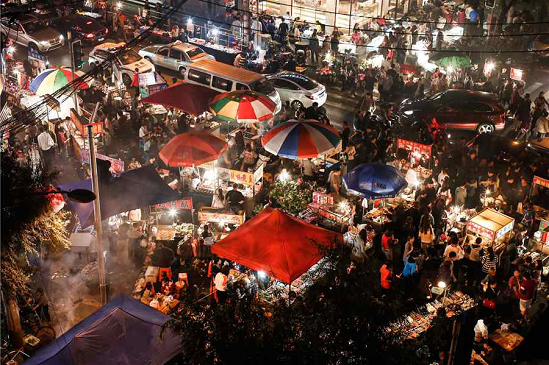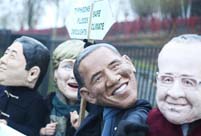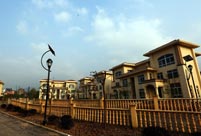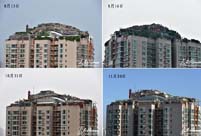 |
| A bird’s eye view of the outdoor Pengpu Night Market that is blamed for causing massive traffic jams. — Yang Yi |
The Shanghai No. 5 Bus Co said it was forced into making changes on some of the bus routes because of traffic jams caused by a night market.
The market is illegal but it is so popular that it has become a sort of an icon for the Pengpu area and even the district.
The Zhabei District government, however, has been unable to drive away the vendors because of the market’s popularity with the locals as well as tourists.
Eight bus lines, including the No. 206, 951 and 912, will make detours from the Wenxi and Linfen roads after 8pm to avoid the congestion created by the Pengpu Night Market.
A district government official said that as the number of stalls increased day by day, it became more and more difficult for government agencies to uproot it from the neighborhood.
There are some 400 stalls set up along the 1,000-meter-long section on Linfen Road. A large crowd meanders along the way till way past midnight everyday.
The official said that the district government will eventually launch a campaign jointly with the police, commerce and industry authorities to clear the road of the illegal vendors and shops.
The Pengpu Night Market started about 10 years ago near the Pengpu Xincun Station on Metro Line 1.
Residents in the neighborhood have long complained about smoke, dirt and noise that come from the night market.
“We avoid going out after 8pm to avoid slipping on the roads which are oily,” said a resident surnamed Chen.
A bus driver, surnamed Yuan, who plies bus No. 206 that passes through the market, said: “It normally takes about 40 minutes to drive through the 1-kilometer section of the road in the night because of the stalls occupying the roads.”
“In day time it takes only 10 minutes,” Yuan said.
Quarrels often break out between the drivers and stall owners who refuse to make way for the buses. Many bus drivers have been beaten up by the owners who are helped by other owners during conflicts.
Linfen Road has two vehicle and two bicycle lanes. The stall owners usually set up food stalls on the bicycle lanes after the urban management officials are done with the day’s work.
Visitors eat in front of the stalls that block the vehicular lanes at night, an official with the bus company said.
The traffic starts building up from 8pm till 2am every day.
“It’s painful for both drivers and passengers,” the official said.
About a dozen cleaners work on the roads in the wee hours after the night market shuts, a cleaner said, adding that stall owners throw the wastes on the road as the market does not have enough rubbish bins.
Apart from food, clothes, cheap jewelry, toys and mobile phone accessories are also sold on the market.
In August 2011, the district government launched a campaign along with the forces of the district’s greenery, urban management, traffic authority and police to crack down on the market. The campaign brought down the number of stalls to the current 400 from over 1,000, the official said.
The district government now plans to increase the number of cleaners in the area before it launches another blitz to try and shut down the stalls.
The city’s legislative body has said it planned to issue new laws to manage the night markets across the city.
The local government will also strengthen the management of night markets by learning from similar spots in Taiwan and Hong Kong, the local legislative body has said.
Those unlicensed food stalls, usually set up on temporary stalls or tricycles, will be cracked down. For other food vendors, the government will set up management committees to ensure food safety and cleanliness.
Local socialist Gu Xiaoming insisted that the city should keep the night market that is popular with both tourists and locals.
Many of the food stuff on offer here are popular with tourists keen to get a feel of traditional local food, Gu said.
 Finland has more eggs in the Chinese basket than any other
Finland has more eggs in the Chinese basket than any other In pictures: PLA's digital equipment
In pictures: PLA's digital equipment  Protesters demonstrate during UN Climate Change Conference in Poland
Protesters demonstrate during UN Climate Change Conference in Poland  Self-made farmer billionaire donates 69 villas at hometown
Self-made farmer billionaire donates 69 villas at hometown Demolition of bizarre rooftop villa in Beijing still in progress
Demolition of bizarre rooftop villa in Beijing still in progress Service seminar for E China train attendants
Service seminar for E China train attendants  Supermodel-turned-designer
Supermodel-turned-designer Cheerleaders light up CBA regular season
Cheerleaders light up CBA regular season  Finland--anytime you want is right time to go: Ambassador
Finland--anytime you want is right time to go: Ambassador Maritime counter-terrorism drill
Maritime counter-terrorism drill College students want partner for sex needs
College students want partner for sex needs Models dazzle at Int'l Yacht Model Pageant
Models dazzle at Int'l Yacht Model Pageant  How to apply for a green card in China
How to apply for a green card in China National Geographic Traveler Photo Contest
National Geographic Traveler Photo Contest Weekly Sports Photos
Weekly Sports PhotosDay|Week|Month